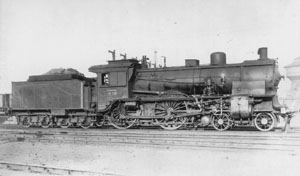| |
BR 13.5
 | | The BR 13 530 |
The steam engines of type S4 were the first superheated steam engines who were bought by the Royal Prussian and the Grand Duchy of Hessian State Railways. Borsig delivered in 1902 the first six locomotives. The inventor of the superheated steam engine principle, Wilhelm Schmidt (1858-1924), tried this for the first time on a fixed steam engine and later it was modified to use it for steam locomotives.
For experimental reasons, the Prussian railways ordered a S3 at Vulcan and a P4 at Henschel with this new superheated mechanism. On 12 April 1898, Vulcan delivered the steam engine as HANNOVER 74, this was the first superheated steam engine in the world. Because this system wasn't yet perfect, W.Schmidt had to alter a couple of things before the locomotive could be made in mass production. The series steam engines built from 1902 was a superheated steam engine with it's own construction and smokebox superheater.
The S4 was able to pull a train of 380 ton on flatlands with a speed of 95 km/h. The steam engine S4 was 30% more powerful than the S3. Until 1909 there are 104 locomotives S4 built by Borsig, Henschel and Humboldt. After this production they changed to the production of the more powerful S6.
The DRG took over only four locomotives S4. The locomotives were entering service as BR 13.5 with the numbers: 13 501 up to 13 504.
| Axle layout: |
2'B h2 |
| In service: |
1907-1909 |
| Diameter driving wheels: |
198 cm |
| Diameter carrying wheels: |
100 cm/- |
Lengte over de buffers
(met tender pr.2'2'T16): |
18,210 m |
| Top speed: |
100 km/h |
| Power: |
1000 pk/hp |
| Weight: |
55,2 t |
|
